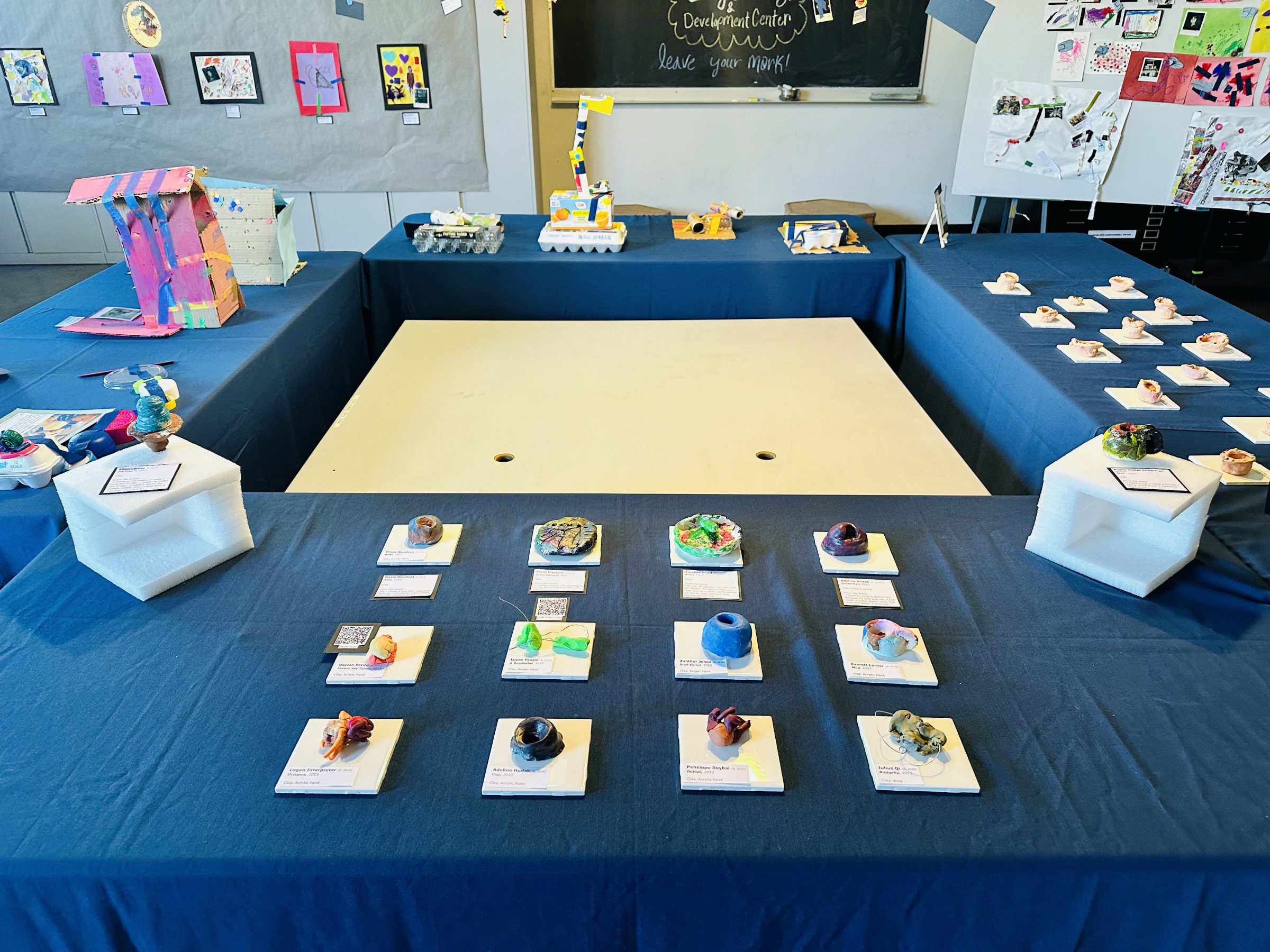
As children explored art materials, they became curious about who makes art and what types of mediums are available.
Phase One: Exploring Visual Art Accordion Closed
Discovery:
The Art Center has been one of the most popular centers in the ELDC classroom. They love painting, drawing, gluing, cutting and creating costumes and props out of recyclable materials. We
have also been exploring art in book illustrations that we read.
Topic Webs:
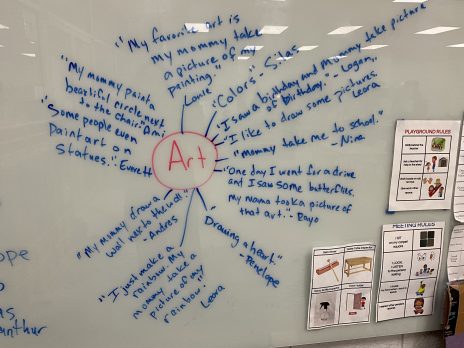
Discovering what our young artists already know about Visual Art and what they would like to learn, children completed a topic web with the teachers to identify concepts related to art.
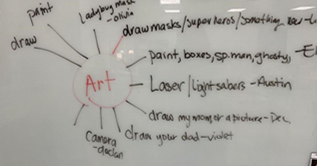
Small Group Color Wheels:
Together, students and teachers discussed the three primary colors. We experimented by mixing the three colors to create our color wheels. Ms. Jolene showed students how to make lines on their circles by folding the paper before drawing the line. Students painted inside the triangles of their color wheel and then took turns mixing their colors, to paint the new color on their wheels.
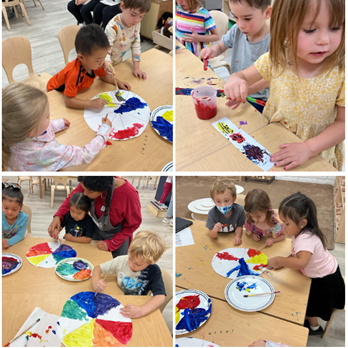
Mouse Paint Read Aloud:
Students furthered their discussion about what they know about art during a read-aloud. They read Mouse Paint, a book about 3 mice who explore the primary colors to create different colors through mixing. During an interactive read-aloud, students used investigation time to explore mixing colors using paint. Mrs. Brena read the book alongside the color mixing to help students grasp the concept of color mixing. As we explored, we encouraged students to pass supplies across the table when needed, they shared one water cup to clean and 3-4 paper towels to clean their brushes.
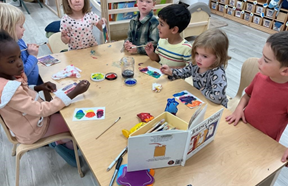
Brena: What color does the mouse make when mixing and stirring and mixing red and yellow?
Andres, Ami, Rayo: Orange!
Brena: Tell me what color you made, Louie.
Louie: I, I mixed, red and blue. I make purple!
Brena: How do we make green?
Caroline: Mine is green, I have green!
Brena: I see that, what two colors did you mix?
Rayo: Yellow and blue.
Experimental Art Accordion Closed
Students experimented with different mediums, investigating what they already knew about the mediums, as well as what they wanted to learn.
Purple Paint:
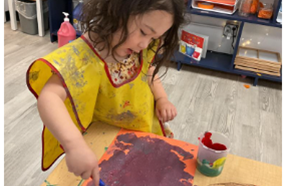
Lily: My mom’s new coffee! It’s purple.
Jolene: How did you make purple?
Lily: I mixed it.
Jolene: What did you mix?
Lily: Purple.
Jolene: We don’t have purple. We have yellow, red, white, and blue. How did you make purple?
Lily: I get two pumps of colors and mixed it.
Mixed Media Art:
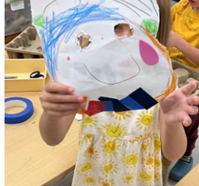
Rayo drew, colored, cut, and taped her art piece. She discovered that she could use several different mediums to use in her single piece of art.
Rayo: Look what I made.
Jolene: What is it?
Rayo: It’s my mom and she’s doing some chores. (She started rolling tape and placing it all over the back.)
Jolene: Why are you putting so much tape on it?
Rayo: Because my Mama is going to hang it on the wall in her office.
Research Intentions:
This project revolved around students’ interests and curiosities about different artists and mediums. Students and teachers decided to focus their research throughout the project on artists from the same cultures’ as our students, as well as investigate the mediums these artists were using. We intended to conduct hands-on research into these mediums and create our versions of these artists’ masterpieces. Alongside hands-on research, teachers and students read books about the chosen artists to learn how art exists as expressions of beliefs, passions, and cultures.
Ms Jolene brought out a map of the world for the children to look at. We are learning about artists from all over the world and where they come from. Students discussed where they were from, and where their families were from.
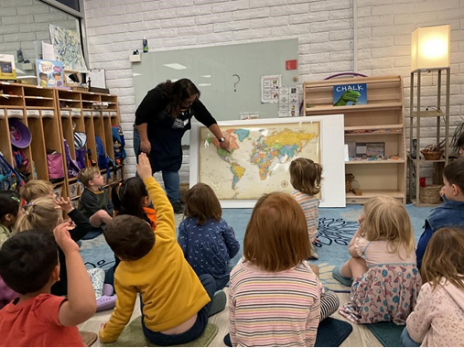
What is this?
Kailani: America?
Silas: Places with people.
Olivia: My mom and dad live in Mexico and in Flagstaff.
Everett: It is a map of different states
J: This is a map. In this classroom we have families from Brazil, Mexico, some of our practicum students are from China, and Malawi.
J: Where is Flagstaff on this map?
Kailani: In Arizona?
J: Yes and where is Arizona on the map, do we know?
Declan, Silas, Marco, and more: I live in Flagstaff!
J: Leora’s family is from Malawi, it is in Africa.
B: they traveled all the way from here *pointing to Africa* to here *pointing to Flagstaff*, how do you think they got here?
Elliot: They filed
Declan: In a plane
J: We are going to ask your families where they are from and put pins on this map so that we can see where we are all from in the classroom.
Phase Two: Art Mediums Accordion Closed
Students experimented with different mediums, investigating what they already knew about the mediums, as well as what they wanted to learn.
Mixed Media Art:
Pointillism:
Children have been using the term “pointillism” when describing art created with dots. One of the artists we learned about is Yayoi Kusama, “the princess of polka dots.” Each dot was part of thousands of others– they made Yayoi feel like she was a single dot that was part of the infinite universe. Children discovered that adding more dots to a drawing could create a new picture; it also made it possible for children to strengthen their vocabulary in math by using terms such as small, medium, big, large, etc.
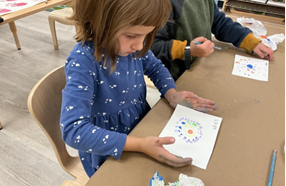
Ceramics:
We talked about pottery during one of our morning meetings.

Jolene: This is a mug Ms. Rebecca brought. It’s a piece of pottery. Is it functional or aesthetic?
Students: Aesthetic!
Jolene: Is it something we can use or is it just to look at?
Everett: Functional.
Jolene: Yes, functional because we can use it.
Zanthur: You can put your juices in there.
Andres: You can drink coffee from it.
Leora: One time my mom had a new water bottle.
Marco: I can drink water in it.
Over days, children were shown how to use the classroom pottery wheel:


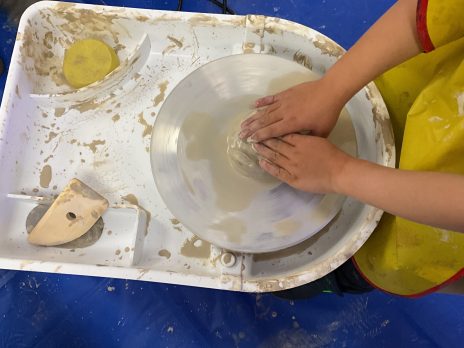
Jolene: If you got to use our new pottery wheel, how was it? Was it easy or hard?
Elliot: It was yucky and slimy like paint.
Louie: I’m going to use the pottery wheel during investigation time today.
Jolene: We need to finish the list from yesterday.
Brena: Is there something you can tell your friends to help them make pottery, like something you wish you knew before you tried it yesterday?
Elliot: I put a hole in it with my thumb to make a fountain.
Jolene: Ms. Bridget said not to do something, do you remember what it was?
Silas: Don’t use your thumb.
Jolene: She said not to put your whole thumb down to the bottom because you will put a hole in it.
Zanthur: We have a pottery wheel at home! I got clay at home too.
Brena: How many hands do we use?
Students: Two hands.
Jolene: Hands need to be wet, why?
Everett: So the clay doesn’t get sticky. As we watched the video on pottery,
Kailani and Andres had questions.
Andres: Why is he putting water inside the cup? Kailani: Why he’s adding too much water, it feels like paint.
Old School Photography:
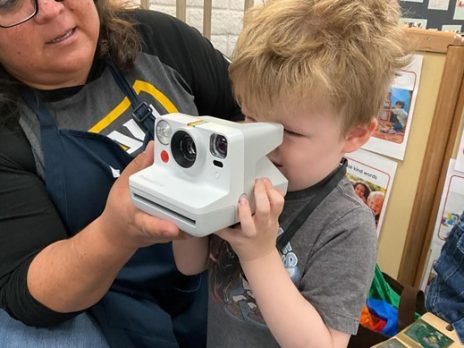
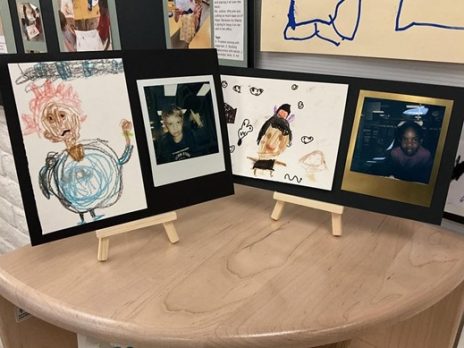
Children discovered parts of a Polaroid camera by understanding how to point and click, understanding where film comes from, and how long it takes for a picture to develop. Each kid took turns taking pictures of each other. During the process, children faced challenges such as: knowing where to focus the camera (some aimed the camera towards the celling, thinking it would capture the picture of their friend), while others closed both eyes when looking through the lens, and some found themselves forgetting to click the bottom to snap a picture. Through these challenges, children learned to control their hands/bodies, understand position of camera, and how film works to bring a picture to life.
Mixed Media Pastiche:
This week our young artists explored mixed-media techniques to create masterpiece pastiches, mixed media collages, and mixed media inspired self portraits. Our young artists experimented with combining photography, painting, collaging, and drawing to create new artwork. They also worked together with their teachers to create an art gallery in Dramatic Play. Our artists were very excited to hang their favorite art in the gallery. Artists and their art techniques seem to be what interest our students most, so we will soon begin to explore their favorite artists more in depth.
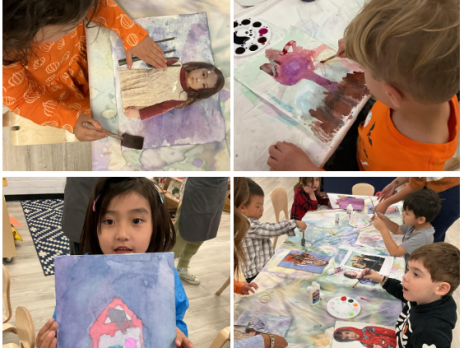
Three Dimensional Art:
Teachers set up a small Makers Space in the art area, including a variety of recyclable materials.
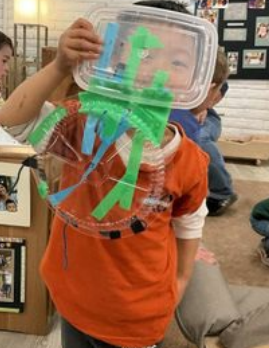
Wire & Clay Sculpture
During SGT, Ms. Jolene explained about some sculptures using more than one medium. Students first bent and formed the wire into something of their own choosing using wire tools. Then they worked with modeling clay to cover their wire sculptures. Students made a variety of different sculptures.
Adeline – Snake Kailani – Circles
Marco – A house Caroline – Boingy slide
Lucas – A beedee tat Rayo – Mine kinda looks like a frog.
Olivia – I made a sculpture. A human. Saige – Circle
Penelope – A rabbit. Austin – I made a porcupine.
Louie – I made a bracelet. Andres – Loops.
Logan – A dead body. Julius – Butterfly.
Lily – Rainbow Everett – It’s a slide Scout – A heart
Leora – A circle.
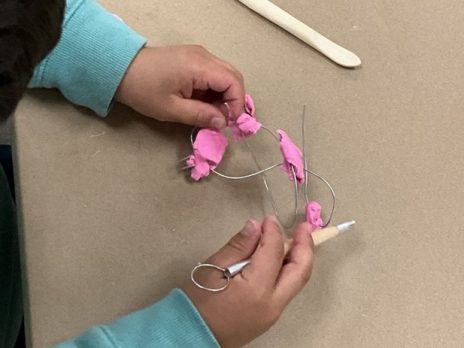

Declan Builds
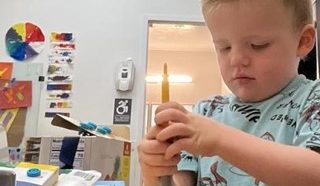
Declan: There’s two excavators. One real one and a fake one. I need a small box.
Ms. Carmen: What if you cut your bigger box’s and make a smaller one?
Declan: I found one! I’m going to put it right here.
Ms. Carmen: What are you going to use to place it there? *Declan picks up screw driver and makes a hole to put a “nail” in*
Declan: We need a little person in the excavators. We need a dad.
Ms. Jolene: Why can’t moms drive excavators?
Declan: Moms can. Everyone can because they are not scared. Not my brother, he’s very strong. Excavators live in the rocks.
Ms. Carmen: Do they only pick up rocks? Declan: No, they pick up sand.
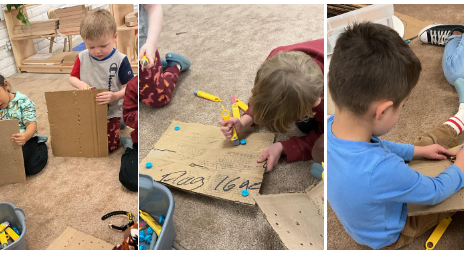
Construction tools:
Brena introduced new tools to use with the cardboard. Each
group talked about the safety of the tools, how to use them and
what ways we can use them. Many of them were intrigued with
using tools with serrated edges and they also were working on
understanding the concept of twisting the screw in one direction.
The introduction of these new tools allows students to use first,
then explore the tools to create during investigation time. She
asked questions about what the tools might be able to do.
Brena: What are some things we can make with these tools?
Kailani: Be careful when you touch the tools.
Weaving:
Children learned about weaving through our life-size classroom loom. Miss Brena’s group worked on weaving fabric strips in and out. Children practiced patterning, directional and fine motor skills.
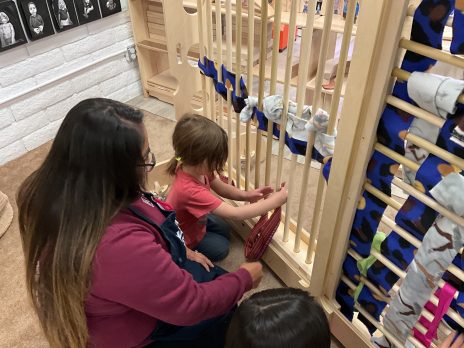
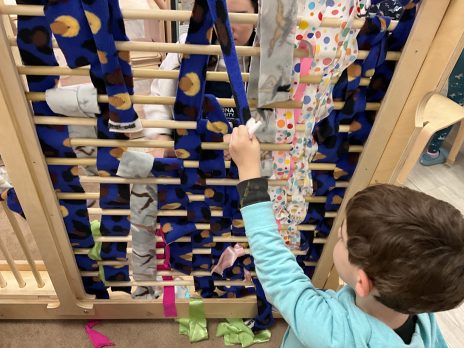
Ms. Brena brought in her Navajo rug as an introduction to textiles, weaving and the loom. During morning meet, both groups sat together to talk about the rug. Several students talked about having rugs of various sizes in their homes. Next, Ms. Brena talked about the look and the use of red and green markings. A quick tutorial was given about how to pass the fabric through the loom with opportunities to have a turn during investigation time. Marco had a 10-minute timer to use the loom, Ms. Brena showed him the Red Green Red Green pattern on the strings. Marco needed to pass his fabric strip into all of the red stings until he got to the end. Next, he turned it around to come back the other direction. Marco caught on and was able to complete a row all on his own before his timer went off.
Artists and Galleries Accordion Closed
Children spent time learning about artists from around the world.
Frida Kahlo
Yayoi Kusama
Jackson Pollock
Jean-Michel Basquiat
In one artist study, we discussed American/Puerto Rican artist Jean-Michel Basquiat. Students looked at pictures of different Basquiat artworks.
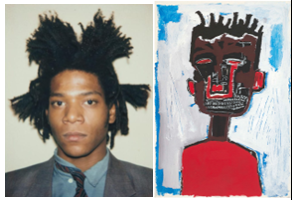
Ms. Jolene: What artists have we studied?
Marco: Frida Kahlo.
Rayo: Jackson Pollock.
Andres: Kusku
Ms. Jolene: Yes, Kusama. Today we’re going to look at the art of Basquiat. Next week we’ll mark on our big map where our families are from and where artists are from. Basquiat lived in America but also in Puerto Rico. What do you see in his paintings?
Kailani: I see a bird.
Silas: It’s a cat!
Ms. Jolene: Basquiat made a self-portrait painting. Who else made a painting of themselves? Silas: I DID!
Ms. Jolene: You did, but so did Frida Kahlo. Students laughed at paintings of cats with wings. Ms. Jolene: What do we call it when we try to make art that looks like an artist’s art? A pastiche. Let’s close our eyes and think of what kind of Basquiat Pastiche we would like to make.
Children enjoyed researching Kusama. After reading several books, children had opportunities to recreate her pieces.
We were inspired by Kusama’s infinity mirrors to create our own kaleidoscopes. The process of creating our project is over the course of 3 days. Students had an opportunity to see a completed kaleidoscope. Day 1: Paint tube rolls and dots on plates. Day 2: Create mirror prisms and finish tube art. Day 3: Construct and complete kaleidoscope.
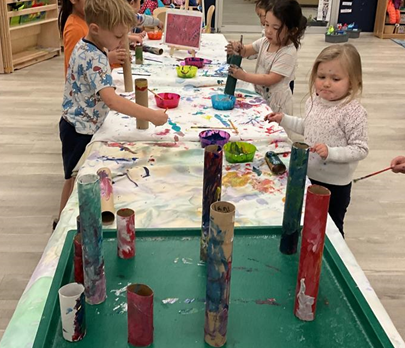

Kusama dress:
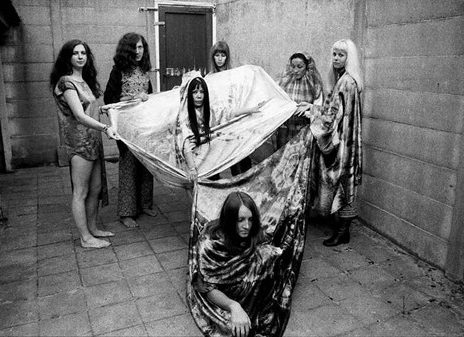
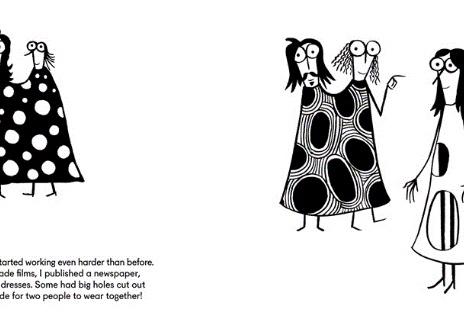
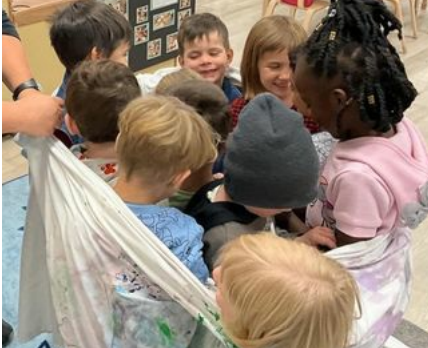
During morning meeting, the teachers discussed Kusama’s multi-person dress. We counted our 11 friends and used one of our painted canvas to make our own Kusama dress! We tried walking, but it was so difficult that we all fell down.
Self portraits like Kahlo:
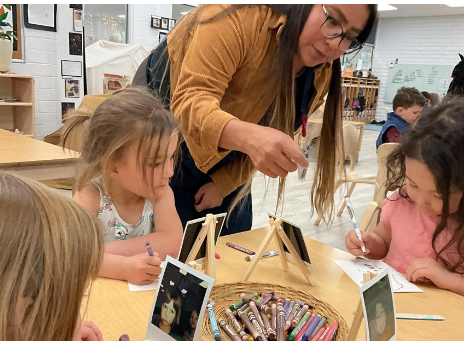
Children and teachers talked about how Frida Kahlo is known for painting her self-portrait. Students used Polaroids of themselves to look at as a model. Children were encouraged to use details and color in their work.
Art galleries and their function:
Miss Carmen worked with the class to create an Art Gallery, showcasing the art made in the classroom. We had conversations about galleries, museums, and respecting people’s artwork. We have also noticed children getting frustrated because their art was not working out as they envisioned. What can we do to avoid destroying art?
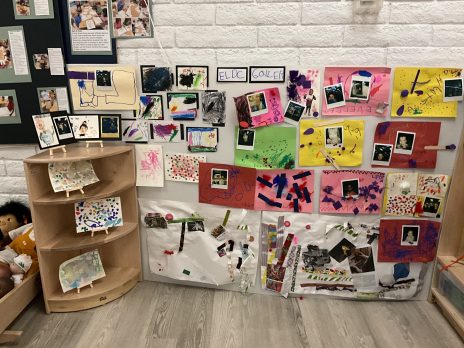
During meeting time, miss Jolene showed her frustration when she was unable to draw a diamond. She tore her paper and threw her materials on the ground!
Brena: Oh, no. What’s happening, Jolene? Students begin laughing.
Brena: Hold on, friends. I don’t think this is a laughing matter, it looks like Jolene is really upset. What’s wrong, Jolene? Jolene: I’m really frustrated. I can’t do it! I can’t draw a diamond.
Brena: I see that Jolene is really mad because she can’t do something the way she wants, what can you think about that can help her?
Silas: But it was really beautiful! You can keep trying.
Violet: Maybe you can take a deep break, Jolene. Jolene takes a deep breath and tries again, and again, and again. Brena: You know, sometimes we get frustrated, Violet said to take a deep breath, did it help, Jolene?
Jolene: It did. Brena: Now, do you think getting mad and destroying her art work was helpful to Jolene?
Students: Noooo.
Jolene: You see, it’s helpful to take a step back from time to time and come back to your work if it makes you mad. Art is about trying, nothing is going to be perfect the first time you try it.
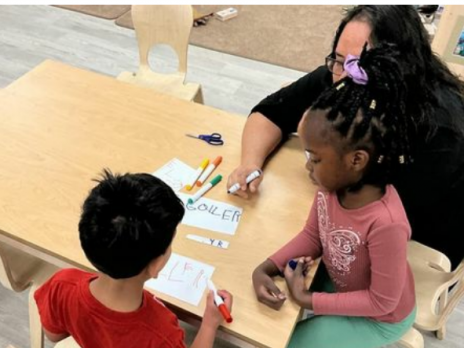
Leora write out our sign for the ELDC gallery. Miss Jolene named letters and Leora wrote them out. Andres came to the table and watched her. He asked if he could also make a sign, and he printed some letters. He proudly showed it to peers and adults in the classroom.
Field experts Accordion Closed
We welcomed NAU Assistant Professor of Art Education Andrew Tegarden and his NAU Art students to the ELDC. They presented a 3 step lesson on Collaging. Step 1 – Andrew did a demo of creating a collage of the first letter of his name on cardboard. Step 2 – Students, with the assistance of teachers, put their first letter on a piece of cardboard. Step 3 – You do it and the students making collages using glue and various materials.
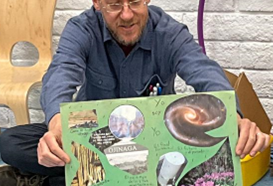

Andrew asked students what they saw in the collage he presented to them.
Kailani I: I see a waterfall
Penelope: I see flowers.
Silas: I see flowers.
Zanthur: I see Mercury.
Andrew: There is a lot in collage that you can just find. And then glue on. What is the first letter of my name?
Louie: A.
Andres: I start with an A too!
Phase 3: Art Gallery Event Accordion Closed
In preparation for our culminating event, we are beginning our discussions for our culminating event.
Jolene: We’re going to talk about art galleries.
Jolene: Anyone know what this one is?
Everett: Frida Kahlo
Zanthur: I don’t see Frida Kahlo.
Jolene: This is her gallery ink Mexico City. Casa Azul.
Brena: Ms. Jolene, can we pause? Can you tell me what you guys see?
Marco: I see a skeleton. Jolene: I see people looking at art. Louie: I see a skeleton.
How do you think those skeletons are made?
Penelope: Maybe glass. Declan: Maybe clay.
Zanthur: I see a silly deer. Caroline: I think it’s a silly man dancing with the skeletons.
Jolene: Look in this corner, what do you see?
Marco: Bad guys *skeletons on wall
Jolene: In the corner, there’s pottery. Look at all the things on the wall, on the ground, on easels. I want you to start thinking about our own art gallery.
Caroline has hand raised. Caroline: I think it’s cactus.
Jolene: Look at those cool stairs, sometimes architecture is art too.
Brena: Look at this space, it’s empty. What would you put in there if you were setting up for our art gallery?
Everett: Sculptures.
Zanthur: My toys
Jolene: Look at that blank wall, what can we do with it?
Everett: Put up wire slide sculptures. Brena: Oh, what is that one word where you paint a whole wall?
Rayo: Mural. Brena: What is an art gallery?
Everett: A gallery that has a bunch of art. Sometimes they have galleries in a whole entire house.
Jolene: This is Frida’s house, she lived here her entire life.
Brena: What kind of art do you want to make to show someone?
Andres: I have murals in my garden and I got some scal-chews (sculptures)
Marco: I want to make a spider man painting.
Caroline: I think people already make those sculptures.
Jolene: They did but we’re going to make our own.
Andres: Sculptures. Jolene: What kind? What can we make them out of?
Everett: Metal.
Lily: But. But, it’s time, I just go to that city. I just saw it with my mom and my dad. My whole family.
Louie: Uhm. Uhm. Uhm, why. Why why Kusama got sick? Ms. Jolene: I don’t know.
Rayo: I’m going to make Frida on my paper.
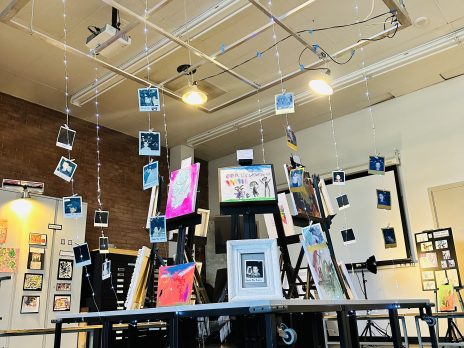
Although this project began with our students sharing a common interest in the art center, it has taken us somewhere special. Yayoi Kusama and Frida Kahlo were house favorites, and they are evident in the facts they recalled. We celebrated our learning by curating specific pieces to display in our final art gallery event.
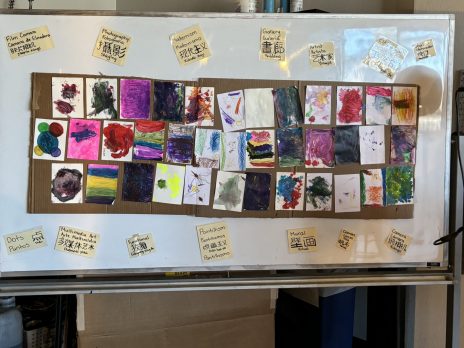
Use the links below to view our students’ reflections on the Art Project:
Phase One: Exploring Visual Art Accordion Closed
Discovery:
The Art Center has been one of the most popular centers in the ELDC classroom. They love painting, drawing, gluing, cutting and creating costumes and props out of recyclable materials. We
have also been exploring art in book illustrations that we read.
Topic Webs:
Discovering what our young artists already know about Visual Art and what they would like to learn, children completed a topic web with the teachers to identify concepts related to art.
Small Group Color Wheels:
Together, students and teachers discussed the three primary colors. We experimented by mixing the three colors to create our color wheels. Ms. Jolene showed students how to make lines on their circles by folding the paper before drawing the line. Students painted inside the triangles of their color wheel and then took turns mixing their colors, to paint the new color on their wheels.
Mouse Paint Read Aloud:
Students furthered their discussion about what they know about art during a read-aloud. They read Mouse Paint, a book about 3 mice who explore the primary colors to create different colors through mixing. During an interactive read-aloud, students used investigation time to explore mixing colors using paint. Mrs. Brena read the book alongside the color mixing to help students grasp the concept of color mixing. As we explored, we encouraged students to pass supplies across the table when needed, they shared one water cup to clean and 3-4 paper towels to clean their brushes.
Brena: What color does the mouse make when mixing and stirring and mixing red and yellow?
Andres, Ami, Rayo: Orange!
Brena: Tell me what color you made, Louie.
Louie: I, I mixed, red and blue. I make purple!
Brena: How do we make green?
Caroline: Mine is green, I have green!
Brena: I see that, what two colors did you mix?
Rayo: Yellow and blue.
Experimental Art Accordion Closed
Students experimented with different mediums, investigating what they already knew about the mediums, as well as what they wanted to learn.
Purple Paint:

Lily: My mom’s new coffee! It’s purple.
Jolene: How did you make purple?
Lily: I mixed it.
Jolene: What did you mix?
Lily: Purple.
Jolene: We don’t have purple. We have yellow, red, white, and blue. How did you make purple?
Lily: I get two pumps of colors and mixed it.
Mixed Media Art:
Rayo drew, colored, cut, and taped her art piece. She discovered that she could use several different mediums to use in her single piece of art.
Rayo: Look what I made.
Jolene: What is it?
Rayo: It’s my mom and she’s doing some chores. (She started rolling tape and placing it all over the back.)
Jolene: Why are you putting so much tape on it?
Rayo: Because my Mama is going to hang it on the wall in her office.
Research Intentions:
This project revolved around students’ interests and curiosities about different artists and mediums. Students and teachers decided to focus their research throughout the project on artists from the same cultures’ as our students, as well as investigate the mediums these artists were using. We intended to conduct hands-on research into these mediums and create our versions of these artists’ masterpieces. Alongside hands-on research, teachers and students read books about the chosen artists to learn how art exists as expressions of beliefs, passions, and cultures.
Ms Jolene brought out a map of the world for the children to look at. We are learning about artists from all over the world and where they come from. Students discussed where they were from, and where their families were from.
What is this?
Kailani: America?
Silas: Places with people.
Olivia: My mom and dad live in Mexico and in Flagstaff.
Everett: It is a map of different states
J: This is a map. In this classroom we have families from Brazil, Mexico, some of our practicum students are from China, and Malawi.
J: Where is Flagstaff on this map?
Kailani: In Arizona?
J: Yes and where is Arizona on the map, do we know?
Declan, Silas, Marco, and more: I live in Flagstaff!
J: Leora’s family is from Malawi, it is in Africa.
B: they traveled all the way from here *pointing to Africa* to here *pointing to Flagstaff*, how do you think they got here?
Elliot: They filed
Declan: In a plane
J: We are going to ask your families where they are from and put pins on this map so that we can see where we are all from in the classroom.
Phase Two: Art Mediums Accordion Closed
Students experimented with different mediums, investigating what they already knew about the mediums, as well as what they wanted to learn.
Mixed Media Art:
Pointillism:
Children have been using the term “pointillism” when describing art created with dots. One of the artists we learned about is Yayoi Kusama, “the princess of polka dots.” Each dot was part of thousands of others– they made Yayoi feel like she was a single dot that was part of the infinite universe. Children discovered that adding more dots to a drawing could create a new picture; it also made it possible for children to strengthen their vocabulary in math by using terms such as small, medium, big, large, etc.

Ceramics:
We talked about pottery during one of our morning meetings.

Jolene: This is a mug Ms. Rebecca brought. It’s a piece of pottery. Is it functional or aesthetic?
Students: Aesthetic!
Jolene: Is it something we can use or is it just to look at?
Everett: Functional.
Jolene: Yes, functional because we can use it.
Zanthur: You can put your juices in there.
Andres: You can drink coffee from it.
Leora: One time my mom had a new water bottle.
Marco: I can drink water in it.
Over days, children were shown how to use the classroom pottery wheel:



Jolene: If you got to use our new pottery wheel, how was it? Was it easy or hard?
Elliot: It was yucky and slimy like paint.
Louie: I’m going to use the pottery wheel during investigation time today.
Jolene: We need to finish the list from yesterday.
Brena: Is there something you can tell your friends to help them make pottery, like something you wish you knew before you tried it yesterday?
Elliot: I put a hole in it with my thumb to make a fountain.
Jolene: Ms. Bridget said not to do something, do you remember what it was?
Silas: Don’t use your thumb.
Jolene: She said not to put your whole thumb down to the bottom because you will put a hole in it.
Zanthur: We have a pottery wheel at home! I got clay at home too.
Brena: How many hands do we use?
Students: Two hands.
Jolene: Hands need to be wet, why?
Everett: So the clay doesn’t get sticky. As we watched the video on pottery,
Kailani and Andres had questions.
Andres: Why is he putting water inside the cup? Kailani: Why he’s adding too much water, it feels like paint.
Old School Photography:


Children discovered parts of a Polaroid camera by understanding how to point and click, understanding where film comes from, and how long it takes for a picture to develop. Each kid took turns taking pictures of each other. During the process, children faced challenges such as: knowing where to focus the camera (some aimed the camera towards the celling, thinking it would capture the picture of their friend), while others closed both eyes when looking through the lens, and some found themselves forgetting to click the bottom to snap a picture. Through these challenges, children learned to control their hands/bodies, understand position of camera, and how film works to bring a picture to life.
Mixed Media Pastiche:
This week our young artists explored mixed-media techniques to create masterpiece pastiches, mixed media collages, and mixed media inspired self portraits. Our young artists experimented with combining photography, painting, collaging, and drawing to create new artwork. They also worked together with their teachers to create an art gallery in Dramatic Play. Our artists were very excited to hang their favorite art in the gallery. Artists and their art techniques seem to be what interest our students most, so we will soon begin to explore their favorite artists more in depth.

Three Dimensional Art:
Teachers set up a small Makers Space in the art area, including a variety of recyclable materials.

Wire & Clay Sculpture
During SGT, Ms. Jolene explained about some sculptures using more than one medium. Students first bent and formed the wire into something of their own choosing using wire tools. Then they worked with modeling clay to cover their wire sculptures. Students made a variety of different sculptures.
Adeline – Snake Kailani – Circles
Marco – A house Caroline – Boingy slide
Lucas – A beedee tat Rayo – Mine kinda looks like a frog.
Olivia – I made a sculpture. A human. Saige – Circle
Penelope – A rabbit. Austin – I made a porcupine.
Louie – I made a bracelet. Andres – Loops.
Logan – A dead body. Julius – Butterfly.
Lily – Rainbow Everett – It’s a slide Scout – A heart
Leora – A circle.


Declan Builds

Declan: There’s two excavators. One real one and a fake one. I need a small box.
Ms. Carmen: What if you cut your bigger box’s and make a smaller one?
Declan: I found one! I’m going to put it right here.
Ms. Carmen: What are you going to use to place it there? *Declan picks up screw driver and makes a hole to put a “nail” in*
Declan: We need a little person in the excavators. We need a dad.
Ms. Jolene: Why can’t moms drive excavators?
Declan: Moms can. Everyone can because they are not scared. Not my brother, he’s very strong. Excavators live in the rocks.
Ms. Carmen: Do they only pick up rocks? Declan: No, they pick up sand.

Construction tools:
Brena introduced new tools to use with the cardboard. Each
group talked about the safety of the tools, how to use them and
what ways we can use them. Many of them were intrigued with
using tools with serrated edges and they also were working on
understanding the concept of twisting the screw in one direction.
The introduction of these new tools allows students to use first,
then explore the tools to create during investigation time. She
asked questions about what the tools might be able to do.
Brena: What are some things we can make with these tools?
Kailani: Be careful when you touch the tools.
Weaving:
Children learned about weaving through our life-size classroom loom. Miss Brena’s group worked on weaving fabric strips in and out. Children practiced patterning, directional and fine motor skills.


Ms. Brena brought in her Navajo rug as an introduction to textiles, weaving and the loom. During morning meet, both groups sat together to talk about the rug. Several students talked about having rugs of various sizes in their homes. Next, Ms. Brena talked about the look and the use of red and green markings. A quick tutorial was given about how to pass the fabric through the loom with opportunities to have a turn during investigation time. Marco had a 10-minute timer to use the loom, Ms. Brena showed him the Red Green Red Green pattern on the strings. Marco needed to pass his fabric strip into all of the red stings until he got to the end. Next, he turned it around to come back the other direction. Marco caught on and was able to complete a row all on his own before his timer went off.
Artists and Galleries Accordion Closed
Children spent time learning about artists from around the world.
Frida Kahlo
Yayoi Kusama
Jackson Pollock
Jean-Michel Basquiat
In one artist study, we discussed American/Puerto Rican artist Jean-Michel Basquiat. Students looked at pictures of different Basquiat artworks.

Ms. Jolene: What artists have we studied?
Marco: Frida Kahlo.
Rayo: Jackson Pollock.
Andres: Kusku
Ms. Jolene: Yes, Kusama. Today we’re going to look at the art of Basquiat. Next week we’ll mark on our big map where our families are from and where artists are from. Basquiat lived in America but also in Puerto Rico. What do you see in his paintings?
Kailani: I see a bird.
Silas: It’s a cat!
Ms. Jolene: Basquiat made a self-portrait painting. Who else made a painting of themselves? Silas: I DID!
Ms. Jolene: You did, but so did Frida Kahlo. Students laughed at paintings of cats with wings. Ms. Jolene: What do we call it when we try to make art that looks like an artist’s art? A pastiche. Let’s close our eyes and think of what kind of Basquiat Pastiche we would like to make.
Children enjoyed researching Kusama. After reading several books, children had opportunities to recreate her pieces.
We were inspired by Kusama’s infinity mirrors to create our own kaleidoscopes. The process of creating our project is over the course of 3 days. Students had an opportunity to see a completed kaleidoscope. Day 1: Paint tube rolls and dots on plates. Day 2: Create mirror prisms and finish tube art. Day 3: Construct and complete kaleidoscope.


Kusama dress:



During morning meeting, the teachers discussed Kusama’s multi-person dress. We counted our 11 friends and used one of our painted canvas to make our own Kusama dress! We tried walking, but it was so difficult that we all fell down.
Self portraits like Kahlo:

Children and teachers talked about how Frida Kahlo is known for painting her self-portrait. Students used Polaroids of themselves to look at as a model. Children were encouraged to use details and color in their work.
Art galleries and their function:
Miss Carmen worked with the class to create an Art Gallery, showcasing the art made in the classroom. We had conversations about galleries, museums, and respecting people’s artwork. We have also noticed children getting frustrated because their art was not working out as they envisioned. What can we do to avoid destroying art?

During meeting time, miss Jolene showed her frustration when she was unable to draw a diamond. She tore her paper and threw her materials on the ground!
Brena: Oh, no. What’s happening, Jolene? Students begin laughing.
Brena: Hold on, friends. I don’t think this is a laughing matter, it looks like Jolene is really upset. What’s wrong, Jolene? Jolene: I’m really frustrated. I can’t do it! I can’t draw a diamond.
Brena: I see that Jolene is really mad because she can’t do something the way she wants, what can you think about that can help her?
Silas: But it was really beautiful! You can keep trying.
Violet: Maybe you can take a deep break, Jolene. Jolene takes a deep breath and tries again, and again, and again. Brena: You know, sometimes we get frustrated, Violet said to take a deep breath, did it help, Jolene?
Jolene: It did. Brena: Now, do you think getting mad and destroying her art work was helpful to Jolene?
Students: Noooo.
Jolene: You see, it’s helpful to take a step back from time to time and come back to your work if it makes you mad. Art is about trying, nothing is going to be perfect the first time you try it.

Leora write out our sign for the ELDC gallery. Miss Jolene named letters and Leora wrote them out. Andres came to the table and watched her. He asked if he could also make a sign, and he printed some letters. He proudly showed it to peers and adults in the classroom.
Field experts Accordion Closed
We welcomed NAU Assistant Professor of Art Education Andrew Tegarden and his NAU Art students to the ELDC. They presented a 3 step lesson on Collaging. Step 1 – Andrew did a demo of creating a collage of the first letter of his name on cardboard. Step 2 – Students, with the assistance of teachers, put their first letter on a piece of cardboard. Step 3 – You do it and the students making collages using glue and various materials.


Andrew asked students what they saw in the collage he presented to them.
Kailani I: I see a waterfall
Penelope: I see flowers.
Silas: I see flowers.
Zanthur: I see Mercury.
Andrew: There is a lot in collage that you can just find. And then glue on. What is the first letter of my name?
Louie: A.
Andres: I start with an A too!
Phase 3: Art Gallery Event Accordion Closed
In preparation for our culminating event, we are beginning our discussions for our culminating event.
Jolene: We’re going to talk about art galleries.
Jolene: Anyone know what this one is?
Everett: Frida Kahlo
Zanthur: I don’t see Frida Kahlo.
Jolene: This is her gallery ink Mexico City. Casa Azul.
Brena: Ms. Jolene, can we pause? Can you tell me what you guys see?
Marco: I see a skeleton. Jolene: I see people looking at art. Louie: I see a skeleton.
How do you think those skeletons are made?
Penelope: Maybe glass. Declan: Maybe clay.
Zanthur: I see a silly deer. Caroline: I think it’s a silly man dancing with the skeletons.
Jolene: Look in this corner, what do you see?
Marco: Bad guys *skeletons on wall
Jolene: In the corner, there’s pottery. Look at all the things on the wall, on the ground, on easels. I want you to start thinking about our own art gallery.
Caroline has hand raised. Caroline: I think it’s cactus.
Jolene: Look at those cool stairs, sometimes architecture is art too.
Brena: Look at this space, it’s empty. What would you put in there if you were setting up for our art gallery?
Everett: Sculptures.
Zanthur: My toys
Jolene: Look at that blank wall, what can we do with it?
Everett: Put up wire slide sculptures. Brena: Oh, what is that one word where you paint a whole wall?
Rayo: Mural. Brena: What is an art gallery?
Everett: A gallery that has a bunch of art. Sometimes they have galleries in a whole entire house.
Jolene: This is Frida’s house, she lived here her entire life.
Brena: What kind of art do you want to make to show someone?
Andres: I have murals in my garden and I got some scal-chews (sculptures)
Marco: I want to make a spider man painting.
Caroline: I think people already make those sculptures.
Jolene: They did but we’re going to make our own.
Andres: Sculptures. Jolene: What kind? What can we make them out of?
Everett: Metal.
Lily: But. But, it’s time, I just go to that city. I just saw it with my mom and my dad. My whole family.
Louie: Uhm. Uhm. Uhm, why. Why why Kusama got sick? Ms. Jolene: I don’t know.
Rayo: I’m going to make Frida on my paper.

Although this project began with our students sharing a common interest in the art center, it has taken us somewhere special. Yayoi Kusama and Frida Kahlo were house favorites, and they are evident in the facts they recalled. We celebrated our learning by curating specific pieces to display in our final art gallery event.

Use the links below to view our students’ reflections on the Art Project: